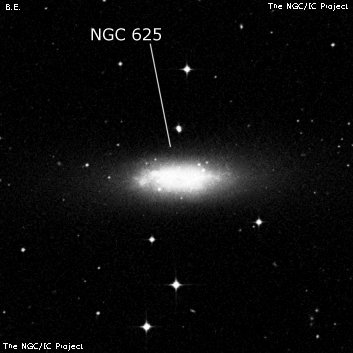
James Dunlop discovered NGC 625 = D 479 = h2426 on 2 Sep 1826 with his 9" reflector and described "a very faint nebula, of a round figure, with two or three minute stars in it near the meridian". His position is ~8' east of ESO 297-005 = PGC 5896. JH logged on 5 Sep 1834, "B, pL, mE, nearly in the parallel; pmbM." On a second sweep on 4 Dec 1836 he called it "B, mE, gbM, 80"." The next night he logged the galaxy again as "B, L, mE, gbM, 1.25' long."
Joseph Turner observed NGC 625 on 24 Jan 1879 with the 48" Melbourne Telescope and noted "it is at present much brighter at the following extremity, giving it the appearance of a tail. This extra brightness is caused by a small star being situated there as shown in the above sketch." His small star appears to be a bright HII region in the galaxy.
400/500mm - 17.5" (11/1/86): fairly bright, fairly large, elongated 5:2 E-W, brighter core. Viewed at a very low elevation (less than 10°).
Notes by Steve Gottlieb